The terms “microsite” and “landing page” are often used in digital marketing, especially when discussing targeted marketing efforts. Both serve distinct purposes and can be incredibly effective when used correctly.
Understanding their differences, advantages, and best use cases can enhance your marketing strategy significantly. Let’s explore the world of microsites vs landing pages.
What is a Microsite?
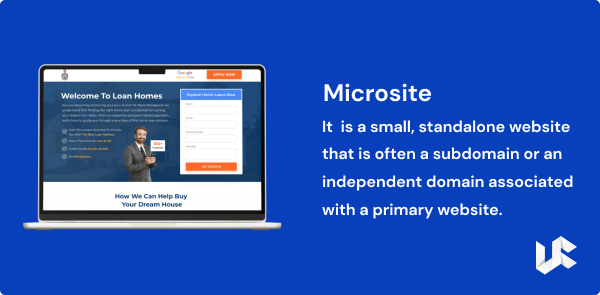
A microsite is a small, standalone website that is often a subdomain or an independent domain associated with a primary website. Unlike traditional websites, which are typically expansive and cover a broad range of topics and services, microsites are focused on a specific campaign, product, event, or theme.
They usually consist of several pages, providing detailed information and interactive experiences.
Key Characteristics of Microsites:
- Brand Awareness Focus:Microsites are often used to build brand awareness and educate the audience about a particular concept. Rich content allows for comprehensive storytelling, fostering brand identity and emotional connection.
- Multi-Page Structure:
Unlike a landing page, a microsite can have several web pages, allowing for a more in-depth exploration of the targeted subject. This can include detailed product descriptions, informative articles, engaging videos, and interactive elements. - Custom Design and Branding:
With a distinct design and domain, microsites offer greater creative flexibility than landing pages that align with the main website’s brand. This freedom allows for bolder design choices and a more immersive user experience. - Interactive Elements:
To engage visitors, interactive features like quizzes, videos, games, and more can be included.
What is a Landing Page?
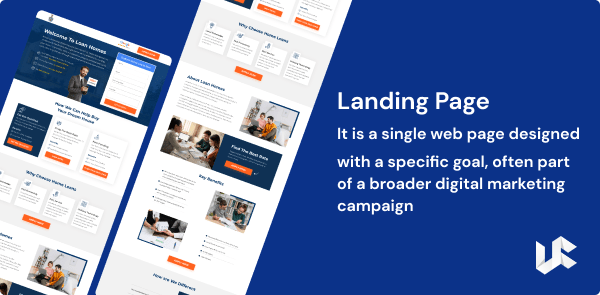
A landing page is a single web page designed with a specific goal, often part of a broader digital marketing campaign. Its primary purpose is to convert visitors into leads or customers by guiding them toward a particular action, such as filling out a form, purchasing, or signing up for a newsletter.
Key Characteristics of Landing Pages:
- Single-Page Focus: Landing pages are singular, providing all necessary information on one page to minimize distractions.
- Alignment with Main Website: Landing pages maintain the same brand identity as the main website, ensuring a seamless user experience post-conversion.
- Minimal Navigation: Landing pages usually have minimal navigation options to prevent users from getting distracted and leaving the page.
- A/B Testing Friendly: Landing pages are prime candidates for A/B testing, allowing marketers to experiment with different design elements, and copywriting to optimize for the highest conversion rate.
Differences Between Microsites Vs Landing Pages
While microsites and landing pages serve specific marketing purposes, their structure, functionality, and use cases differ significantly.
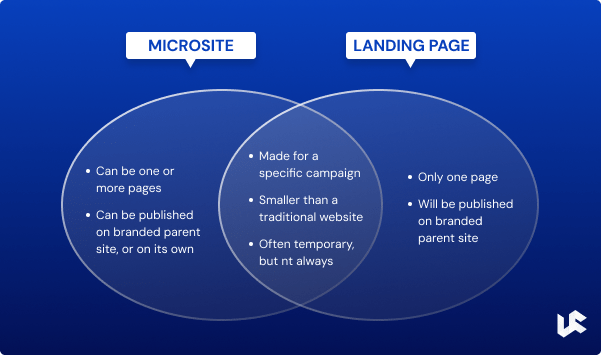
Purpose and Scope:
- Microsite: Designed for comprehensive campaigns, product launches, or events that require detailed information and multiple interactions.
- Landing Page: Created for targeted marketing efforts aimed at immediate conversions, such as capturing leads or making sales.
Content Depth:
- Microsite: Provides extensive information across multiple pages, offering a richer user experience.
- Landing Page: Delivers concise information focused on driving a specific action.
User Experience:
- Microsite: Engages users with interactive elements and a narrative that unfolds across several pages.
- Landing Page: Offers a streamlined experience with all necessary information on a single page.
Design and Customization:
- Microsite: Often features unique designs and branding elements distinct from the main website, allowing for creative freedom.
- Landing Page: This page typically adheres to the main website’s design but has a simplified layout focused on the CTA.
Advantages of Microsites
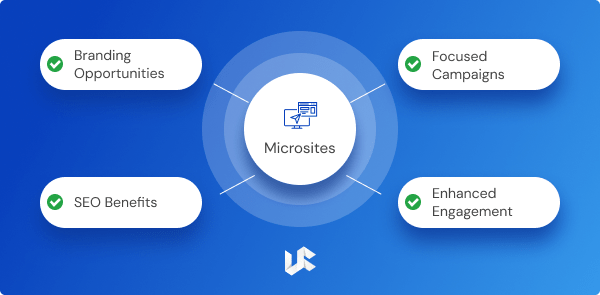
- Branding Opportunities:Microsites allow for creative freedom, enabling brands to create unique and memorable experiences that can stand apart from the main website.
- Focused Campaigns:Are ideal for launching dedicated campaigns, such as new product lines or special events, and provide all necessary information and resources in one place.
- SEO Benefits:Microsites can rank for specific keywords with their domains or subdomains, enhancing SEO efforts related to the campaign or theme.
- Enhanced Engagement:Microsites’ interactive and detailed nature can lead to higher user engagement and longer session durations.
Advantages of Landing Pages
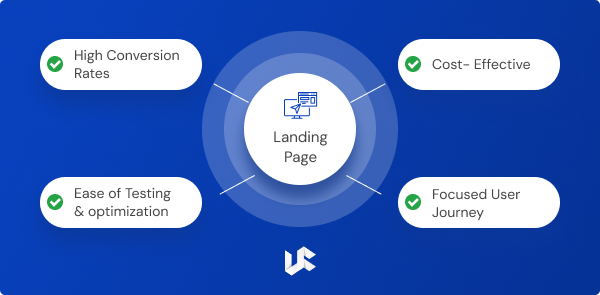
- High Conversion Rates:Designed with a single goal in mind, landing pages are optimized to drive conversions, capture leads, or make sales.
- Cost-Effective:They are typically cheaper and faster to create than microsites, making them ideal for short-term campaigns.
- Ease of Testing and Optimization:Landing pages are perfect for A/B testing, allowing marketers to test and optimize different elements to improve conversion rates quickly.
- Focused User Journey:With minimal distractions, landing pages guide users directly toward the CTA.
Helpful Suggestion: Landing Page Do’s and Don’ts For Higher Conversions
Making the Choice: Microsite vs. Landing Page
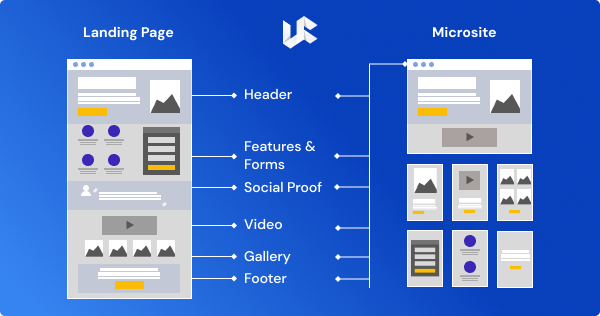
Now that we understand the core differences let’s explore which option best suits your marketing goals:
Choose a Microsite If:
- You aim to build brand awareness and educate your audience about a new product line or service.
- You want to showcase rich, multi-layered content like videos, articles, and interactive elements.
- You seek creative freedom in design and messaging to create a unique brand experience.
- Your campaign has a flexible timeframe, lasting weeks or even years.
Choose a Landing Page If:
- Your primary goal is to drive conversions like sign-ups, sales, or downloads.
- You prioritize clear messaging and an optimized call to action.
- You want to integrate the landing page with your main website seamlessly.
- You have a specific campaign with a defined timeframe.
Case Studies
Let’s explore a few case studies from successful brands to understand better the practical applications and effectiveness of microsites vs landing pages.
Microsite Case Study: Coca-Cola’s “Ahh” Campaign
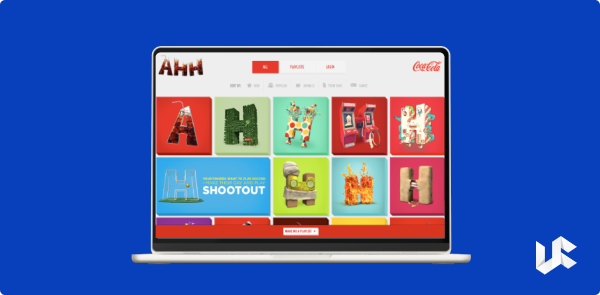
- Objective: Coca-Cola aimed to engage teenagers with an interactive, fun, and unique experience that went beyond traditional advertising.
- Execution: Coca-Cola created a series of microsites, each with a different “Ahh” experience (such as games, videos, and interactive content). Each microsite was designed to be playful and engaging, reflecting the brand’s vibrant personality.
- Results: The microsites generated significant engagement, with users spending more time interacting with the content than standard advertising. The campaign also enhanced brand recall and affinity among the target audience.
- Key Takeaway: Microsites can effectively engage users with interactive content and create memorable brand experiences.
Read the full Coco -Cola Miscrosite case study here
Landing Page Case Study: Zola
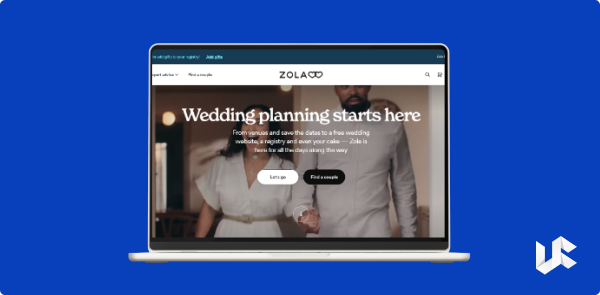
- Objective: Scale digital marketing efforts to align with company growth and diverse product offerings while enhancing user engagement and boosting conversions.
- Execution: Zolo developed 300+ targeted landing pages on Unbounce, tailored to audience segments like Pinterest users and couples interested in registry styles, ensuring seamless alignment with targeted ads.
- Results: Zola saw a 5% to 20% boost in conversion rates with new landing pages, shaping the design of their main homepage based on insights from these successful pages.
- Key Takeaway: Highly targeted landing pages can significantly improve conversion rates and user experience. By tailoring content to specific audience segments, Zola achieved a successful marketing strategy.
Conclusion
Microsites vs landing pages are valuable tools for achieving various marketing objectives. Understanding their strengths and weaknesses allows you to select the most effective option for your needs. By considering factors like campaign goals, target audience, and desired user experience, you can create engaging experiences that drive brand awareness and conversions.
Remember, a winning digital marketing strategy might even involve combining microsites and landing pages to achieve your marketing goals. By leveraging each’s unique strengths, you can build a comprehensive and effective digital marketing campaign that captures attention, engages users, and drives conversions.
Let’s Get Started
It has survived not only five centuries, but also the leap into electronic typesetting, remaining
View More



